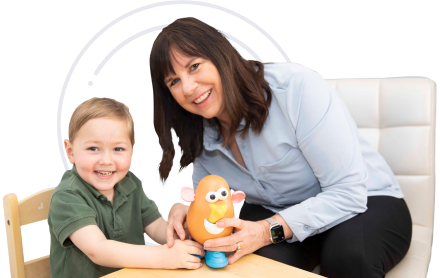Building Imitation Skills in Toddlers with Autism or Showing Signs of Autism
Want to Learn how to Increase Talking & Decrease Tantrums in Children with Autism or Toddlers Showing Signs?
Want to start making a difference for your child or clients?

I have been featuring a lot of guests but I am here solo to talk to you about a critical skill featured in my book, Turn Autism Around. We are talking about building imitation skills in toddlers with autism or showing signs of autism.
I discovered I should talk about this pivotal skill when it was asked during a Q & A call for members of my paid course. I created a short video blog on this topic and in this episode, I am sharing the incredible importance of this skill as well as the 4 steps involved in building it.
Why is imitation important?
All babies, toddlers, and children learn most of their language and social skills through imitation. By 8 months, a typical baby should be imitating simple actions such as clapping hands or tapping the table. By age 2, a typical toddler should be imitating everything. Delays in these skills can be seen in children with autism, it doesn’t always mean autism but any delay can and should be treated. Imitation is critical for language, play, and social skills. So, what are the 4 steps?
Assessment
It’s important to assess on command as well as naturally. Watching the child, if they see their sibling or peer play with a toy, will they do the same thing with the toy? Assessing on command involves specifically modeling the motion. Start by saying, “Do This!” and then modeling the desired action. I go over the skills to be assessed, how, and in what order. You can find my assessment forms online as a book bonus for free with or without book purchase.
Planning and Teaching
My Early Learner Programs, highlighted in my book. are a variety of programs and activities that are beneficial in building and teaching imitation skills. I reference specific materials necessary to implement effective teaching and of these skills. It’s important to use the child’s natural environment but also dedicate time to skill work at the table, always keeping it fun! For a visual example of how to teach imitation check out the video blog that goes along with this episode here.
Easy Data Collection
I try to focus on not getting bogged down by data. My recommendation is to pick 3-5 different targets per program to take data on.
With these steps, the specific activities and the personal experiences I share in this episode, you can effectively understand where the child’s imitation skills stand and how to build them up. Remember that imitation skills can build behavior momentum and are a pivotal skill to all learning.
Always be gentle, never over prompt, and have fun with it!
You’ll Learn
- Why are imitation skills important?
- The 4 Steps: Assessment, Planning, Teaching, Easy Data Collection
- How imitation skills can build behavior momentum.
- About the Turn Autism Around program
Resources
- TurnAutismAround.com
- MaryBarbera.com/workshop (Sign up for a free workshop online for parents and professionals)
- Teaching Object Imitation to Children with Autism
- #090: Apraxia and Autism: What is Apraxia of Speech | Interview with Tamara Kasper
- Autism Video Modeling
- #029: Talk Tools & Speech Therapy for Autism with Mags Kirk
- Delayed Echolalia and Scripting in Children with Autism